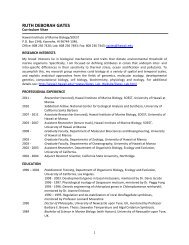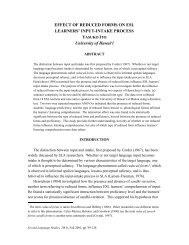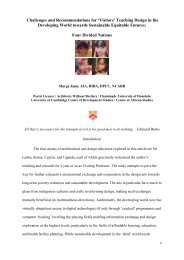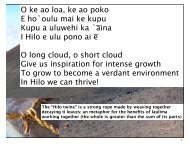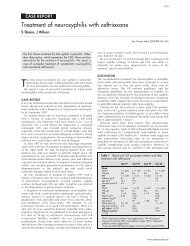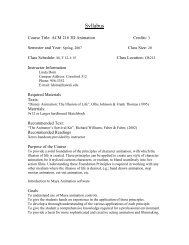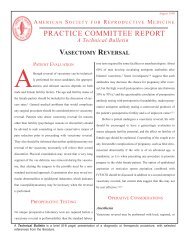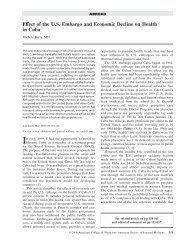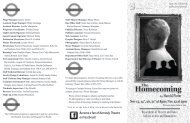Tying and Untying the Trouser-Cord - University of Hawaii
Tying and Untying the Trouser-Cord - University of Hawaii
Tying and Untying the Trouser-Cord - University of Hawaii
Create successful ePaper yourself
Turn your PDF publications into a flip-book with our unique Google optimized e-Paper software.
60 J. W. Frembgen<br />
(Narayan 1989, p. 121). Somebody who ‘opens his trouser-cord for everyone’, which<br />
corresponds to <strong>the</strong> Punjabi saying nare da bara tela owe, is obviously a person who<br />
cannot control his nafs, that is his lower <strong>and</strong> animal self. He yields to <strong>the</strong><br />
undisciplined sinful impulses <strong>of</strong> his nafs. A man would also be called izar-b<strong>and</strong> ka<br />
dhila (a libidinous man, a debauchee), derived from dhil */‘<strong>the</strong> state <strong>of</strong> being<br />
loose’*/or more poetically ‘ashiq-mizaj (a womaniser), unworthy <strong>of</strong> trust (be-wafa).<br />
Referring to women, <strong>the</strong> Pashto saying baga har chatha peranzy thal */‘She is opening<br />
her trouser-cord to everyone’*/means a prostitute, <strong>and</strong> izar-b<strong>and</strong> ki dhili in Urdu<br />
simply means ‘a woman <strong>of</strong> easy virtue’. Never<strong>the</strong>less, in daily discourse in Indo-<br />
Pakistan, proverbs <strong>and</strong> sayings <strong>of</strong> that kind are mostly used while talking about men.<br />
In <strong>the</strong> Turkish language similar expressions almost always refer to men: uçkuruna<br />
düskün means somebody who cannot control himself, who is addicted to chasing<br />
after women, <strong>and</strong> uçkuru gers¸ek means somebody who keeps his ‘inner belt’ loose.<br />
In Pakistan, <strong>the</strong> way <strong>of</strong> wearing traditional dress <strong>and</strong> particularly <strong>the</strong> trouser-cord<br />
<strong>of</strong>fers a range <strong>of</strong> behaviour, from charm to explicit affront observable in everyday<br />
behaviour, as by ‘village Romeos’ who try to entice women to sit in body postures<br />
where <strong>the</strong>ir splendidly decorated trouser-cords are intentionally visible from under<br />
<strong>the</strong>ir shirts. Sometimes <strong>the</strong>y even play with both <strong>of</strong> <strong>the</strong>ir tassels to make a show <strong>of</strong><br />
<strong>the</strong>ir physical attraction. When I frequently saw <strong>the</strong>se tassels with pendants in remote<br />
parts <strong>of</strong> Indus Kohistan, <strong>the</strong>ir form <strong>of</strong>ten reminded me <strong>of</strong> testicles <strong>and</strong> seed-threads.<br />
This erotic dimension becomes clear if we imagine <strong>the</strong> appearance <strong>of</strong> <strong>the</strong> lala (lit. ‘big<br />
bro<strong>the</strong>r’), that is, <strong>the</strong> urban d<strong>and</strong>y (who could be seen in Peshawar until <strong>the</strong> 1960s<br />
<strong>and</strong> 1970s), <strong>and</strong> his image construction through a particular way <strong>of</strong> dressing. He<br />
would come to amuse himself in public parks <strong>and</strong> gardens, for instance in Shahibagh,<br />
arriving in a beautifully decorated tanga (horse-carriage). The lala would wear<br />
a white latha-shalwar, made <strong>of</strong> cotton, <strong>and</strong> a cream-coloured (boski) silken qamiz.<br />
The end <strong>of</strong> his grey silk turban would hang down to his left knee. On that side he also<br />
wore a dagger in his belt. Finally, on <strong>the</strong> right side, <strong>the</strong> ends <strong>of</strong> <strong>the</strong> trouser-cord with<br />
<strong>the</strong>ir elaborately decorated pendants would be provocatively draped hanging down to<br />
<strong>the</strong> knee. In Lahore, <strong>the</strong> phund (lit. yellow hornet), that is, a stud or player, would<br />
roughly correspond to <strong>the</strong> Peshawari lala.<br />
These examples show that pieces <strong>of</strong> dress (like <strong>the</strong> trouser-cord) are ‘a flexible<br />
medium people manipulate to project <strong>the</strong> kind <strong>of</strong> public image <strong>the</strong>y want o<strong>the</strong>rs to<br />
know <strong>the</strong>m by’ (Rugh 1986, p. 3). Never<strong>the</strong>less, as a ‘text’, <strong>the</strong> visibility <strong>of</strong> <strong>the</strong> string in<br />
<strong>the</strong> public space can be ‘read’ differently <strong>and</strong> <strong>the</strong>refore carries an ambiguous meaning:<br />
does <strong>the</strong> person want to communicate an erotic signal or not? Within <strong>the</strong> temporal<br />
chain <strong>of</strong> cause <strong>and</strong> effect, <strong>the</strong> receiver <strong>of</strong> <strong>the</strong> signal can never be sure if <strong>the</strong> cord is just<br />
accidentally visible, out <strong>of</strong> negligence, or provocatively displayed implying an<br />
exhibitionistic urge. This ambiguity is also found, probably to a somewhat<br />
lesser extent, within <strong>the</strong> intimacy <strong>of</strong> legal sexuality lived by a married couple,<br />
where <strong>the</strong> revealing <strong>of</strong> <strong>the</strong> trouser-cord may convey erotic fancies <strong>and</strong> expectations.<br />
A closer look in relevant dictionaries brings a number <strong>of</strong> idiomatic expressions<br />
to light which show clear sexual connotations (Fallon 1989[1879], pp. 79 /80;



